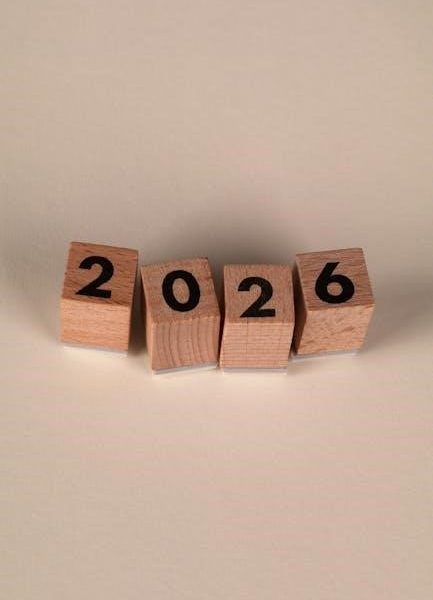Improper fractions have a numerator greater than the denominator‚ representing more than one whole. Mixed numbers combine a whole number with a proper fraction‚ making them easier to understand in real-world contexts.
1.1. Definition of Improper Fractions
An improper fraction is a fraction where the numerator is greater than or equal to the denominator‚ resulting in a value greater than one. For example‚ ( rac{7}{3} ) is an improper fraction because 7 divided by 3 equals 2 with a remainder of 1. These fractions are often converted to mixed numbers for easier interpretation in real-world applications. They are fundamental in mathematics‚ especially in operations involving division and multiplication of whole numbers and fractions.
1.2. Definition of Mixed Numbers
A mixed number combines a whole number and a proper fraction‚ representing a value greater than one. For instance‚ 2½ (2 and a half) is a mixed number. Mixed numbers are useful in everyday measurements‚ such as cooking or construction‚ where whole quantities and parts are both relevant. They provide a clear and intuitive way to express values that are not whole numbers‚ making them essential in various practical applications and mathematical problem-solving scenarios.
1.3. Importance of Converting Improper Fractions to Mixed Numbers
Converting improper fractions to mixed numbers simplifies understanding complex values‚ making them easier to interpret in real-life situations. Mixed numbers provide a clear visual breakdown of whole units and remaining parts‚ enhancing problem-solving skills and practical applications. This conversion is essential for fractions operations‚ enabling better comprehension and accurate computations‚ which are fundamental in math education and everyday tasks.

Step-by-Step Guide to Converting Improper Fractions to Mixed Numbers
Converting improper fractions involves dividing the numerator by the denominator to find the whole number and remainder‚ then combining them into a mixed number easily.
2.1. Understanding the Division Process
Converting improper fractions to mixed numbers involves division. Divide the numerator by the denominator to find the whole number and remainder. This process is fundamental for conversion. The whole number represents how many times the denominator fits into the numerator‚ while the remainder becomes the new numerator in the mixed number. For example‚ dividing 7 by 3 gives 2 with a remainder of 1‚ resulting in the mixed number 2 1/3. This step-by-step division ensures accuracy and clarity in the conversion process.
2.2. Identifying the Whole Number and Remainder
When converting improper fractions‚ divide the numerator by the denominator. The quotient is the whole number‚ and the remainder becomes the new numerator. For example‚ in 7/3‚ dividing 7 by 3 gives a quotient of 2 and a remainder of 1‚ forming the mixed number 2 1/3. It’s crucial to ensure the remainder is less than the denominator to maintain the fraction’s integrity. This step is vital for accurate conversion and simplifies understanding mixed numbers in practical applications.
2.3. Writing the Mixed Number
After identifying the whole number and remainder‚ combine them to form the mixed number. Place the whole number first‚ followed by the remainder as the numerator over the original denominator. For example‚ if the improper fraction is 9/4‚ dividing gives a whole number of 2 with a remainder of 1‚ resulting in the mixed number 2 1/4. This step ensures clarity and accuracy‚ making the mixed number easy to interpret and use in further calculations or real-world applications.

Benefits of Using Worksheets for Practice
Worksheets provide a structured learning environment‚ enhancing problem-solving skills and reinforcing mathematical concepts. They offer clear examples and exercises‚ making practice efficient and engaging for students of all levels.
3.1. Structured Learning Environment
Worksheets provide a structured learning environment by offering clear instructions‚ examples‚ and exercises. They guide students through the step-by-step process of converting improper fractions to mixed numbers‚ ensuring understanding. Organized by grade levels‚ these resources cater to different learning paces and abilities‚ making practice systematic and effective. With varied exercises‚ such as matching improper fractions to mixed numbers or ordering them‚ worksheets create a comprehensive and engaging way to master the concept.
3.2. Improved Problem-Solving Skills
Worksheets enhance problem-solving skills by providing exercises that require application of fraction concepts. Students practice converting improper fractions to mixed numbers‚ ensuring understanding through repetition. Matching exercises and word problems encourage critical thinking and practical application. Regular practice strengthens mathematical reasoning and builds confidence in tackling complex fraction problems‚ making worksheets an essential tool for skill development. This structured approach helps students master the concept effectively.
3.3. Reinforcement of Mathematical Concepts
Worksheets provide consistent practice‚ reinforcing the understanding of improper fractions and mixed numbers. By repeatedly converting improper fractions to mixed numbers‚ students internalize the process‚ making the concept second nature. These exercises also connect to broader mathematical principles‚ such as division and whole number operations‚ strengthening foundational skills. Regular practice ensures long-term retention and prepares students for more complex fraction problems in higher-grade levels. Worksheets are a reliable way to build and maintain mathematical proficiency.
Features of a Good Improper Fractions to Mixed Numbers Worksheet
A good worksheet should have clear instructions‚ examples‚ and varied difficulty levels. It should provide ample space for calculations and answers‚ ensuring neatness and organization. Additionally‚ it should include a mix of numerical and word problems to apply the concept in different contexts. A key with answers at the end allows students to check their work and learn from mistakes. Customization options and visual aids can enhance understanding and engagement‚ making the worksheet both effective and user-friendly for students.
4.1. Clear Instructions and Examples
Clear instructions and examples are essential for effective learning. They guide students through the process of converting improper fractions to mixed numbers‚ ensuring understanding. Step-by-step examples help learners grasp the method‚ while practice problems reinforce the concept. Visual aids‚ such as diagrams or number lines‚ can further clarify the process. Worksheets with detailed explanations and answers enable students to self-check their work‚ fostering independence and confidence. This structured approach ensures that students can follow along without confusion‚ making learning more efficient and enjoyable. Properly designed examples cater to different learning styles‚ aiding both visual and kinesthetic learners. Additionally‚ clear instructions help educators deliver consistent teaching methods‚ aligning with curriculum standards and enhancing overall educational outcomes. By providing a solid foundation‚ clear instructions and examples empower students to master the concept of converting improper fractions to mixed numbers effectively.
4.2. Varied Difficulty Levels
Varied difficulty levels in worksheets ensure that learners of all abilities can engage effectively. Beginners can start with simpler problems‚ such as converting smaller improper fractions‚ while advanced students tackle more complex ones with larger numerators or denominators. This gradual progression helps build confidence and reinforces understanding. Mixed difficulty levels also prevent learners from becoming complacent‚ encouraging continuous improvement. Worksheets that cater to different skill levels are more inclusive‚ making them suitable for diverse classrooms and individual learning needs. This approach promotes a balanced and effective learning experience‚ ensuring that every student is challenged appropriately. By offering a range of problem types‚ worksheets with varied difficulty levels keep the learning process engaging and dynamic‚ helping students to master the conversion process step by step. This versatility is particularly valuable for educators seeking to differentiate instruction and meet the unique needs of their students. Overall‚ varied difficulty levels enhance the educational value of worksheets‚ making them a powerful tool for teaching improper fractions to mixed numbers conversion. Balancing simplicity and complexity ensures that no student is left behind or bored‚ fostering a positive and productive learning environment. Worksheets with varied difficulty levels are thus an essential resource for any math curriculum focused on fractions. They provide a comprehensive and adaptable framework for developing and assessing skills in this fundamental area of mathematics.
4.3. Space for Calculations and Answers
Ensuring ample space for calculations and answers is crucial for effective learning. Worksheets with dedicated areas for working out problems help students organize their thoughts‚ reducing clutter and mistakes. Clear sections for writing steps and final answers make it easier for learners to track their progress and for educators to review their work. This feature promotes neatness‚ accuracy‚ and accountability. Adequate spacing also accommodates different handwriting sizes‚ ensuring comfort and readability. By providing sufficient room‚ worksheets encourage a systematic approach to problem-solving‚ helping students develop good study habits. This thoughtful design element enhances the overall usability of the worksheet‚ making it a practical tool for teaching and learning improper fractions to mixed numbers conversion. Proper spacing also reduces visual overwhelm‚ allowing learners to focus on the task at hand without distractions. This attention to detail in worksheet design contributes to a more positive and productive learning experience‚ fostering better understanding and retention of mathematical concepts. Ultimately‚ well-structured worksheets with ample space for calculations and answers are indispensable for effective education in fractions.
Popular Worksheets Available Online
Popular worksheets for grades 4-7 are widely available online‚ offering structured exercises to practice converting improper fractions to mixed numbers effectively.
5.1. Grade 4 Fractions Worksheet
The Grade 4 fractions worksheet focuses on converting improper fractions to mixed numbers through structured exercises. It includes clear instructions and examples‚ making it ideal for young learners to grasp foundational concepts. Each worksheet contains 20 problems‚ ensuring ample practice. The denominators are between 2 and 12‚ aligning with curriculum standards. Available in PDF format‚ these worksheets are easy to download and print‚ providing a convenient way for students to enhance their fraction skills.
5.2. Grade 5 Fractions Worksheets
Grade 5 fractions worksheets offer exercises for converting improper fractions to mixed numbers‚ suitable for advanced elementary students. With denominators ranging from 2 to 12‚ these sheets provide varied difficulty levels. Each worksheet includes 20 problems‚ ensuring thorough practice. Available in PDF format‚ they are easily downloadable and printable. These resources help students master fraction conversion‚ reinforcing mathematical understanding and problem-solving abilities through structured and engaging exercises.
5.3. Grade 6 and 7 Worksheets
For older students‚ Grade 6 and 7 worksheets offer more advanced exercises in converting improper fractions to mixed numbers. These sheets are designed to reinforce previous learning and introduce more complex problems. Available in PDF format‚ they provide a structured way to practice fraction conversion‚ ensuring a smooth transition to higher-level mathematics. With varied difficulty levels and clear instructions‚ these worksheets are ideal for strengthening problem-solving skills and mathematical confidence in pre-teen learners.
How to Download and Use PDF Worksheets
Download PDF worksheets from reliable sources‚ ensuring access to high-quality materials. Print or open them in browsers for easy use‚ and customize as needed for tailored practice sessions.
6.1. Finding Reliable Sources
Reliable sources for worksheets include educational websites like k5learning.com and corbettmaths.com. These platforms offer high-quality‚ grade-specific resources. Look for websites with clear instructions‚ varied difficulty levels‚ and printable options. Ensure the worksheets align with your curriculum or skill level for effective practice. Trusted sources often provide free PDFs‚ making it easy to download and use. Always verify the credibility of the website to ensure accuracy and relevance of the content.
6.2. Printing and Distributing Worksheets
Worksheets are often available in PDF format‚ making them easy to print. Use the print button on the website or download the PDF first. Ensure your printer settings match the worksheet size. Distribute the worksheets in classrooms or as homework. Many sites allow customization‚ so you can tailor them to your needs. Organize the worksheets by grade or difficulty level for structured learning. Ensure all students have access to the materials for consistent practice and understanding.
6.3. Customizing Worksheets for Specific Needs
Customizing worksheets allows teachers to tailor exercises to students’ skill levels. Adjust difficulty by changing numerators or denominators. Focus on specific concepts‚ like word problems or mixed number conversions. Some worksheets offer editable fields for personalized questions. Teachers can also add visual aids or examples to enhance understanding. Customization ensures targeted practice‚ helping students master improper fractions and mixed numbers effectively. This flexibility makes learning more engaging and relevant to individual or classroom needs.

Practice Questions and Exercises
Engage with exercises like matching improper fractions to mixed numbers‚ ordering fractions‚ and solving word problems. These activities reinforce understanding and application of fraction conversion skills effectively.
7.1. Matching Improper Fractions and Mixed Numbers
Matching exercises pair improper fractions with their corresponding mixed numbers‚ enhancing recognition and conversion skills. For example‚ students match 7/4 with 1 3/4‚ fostering a clear understanding of how improper fractions translate into whole numbers and remainders. This activity ensures learners can visually connect the two representations‚ improving their ability to convert fractions accurately and confidently.
7.2. Ordering Improper Fractions
Ordering improper fractions involves arranging them from least to greatest or vice versa. This skill requires understanding how to compare fractions with different denominators. For instance‚ comparing 5/3‚ 7/4‚ and 9/5 helps students recognize the relationships between numerators and denominators. By converting each to a mixed number or decimal‚ learners can easily determine the order‚ enhancing their fraction comparison skills and mathematical reasoning abilities in a structured and engaging manner.
7.3. Word Problems Involving Mixed Numbers
Word problems with mixed numbers require applying real-world context to mathematical operations. For example‚ calculating the total time spent on activities when given durations like 2 1/4 hours and 3 3/8 hours. These problems enhance understanding of practical applications‚ reinforcing the conversion between improper fractions and mixed numbers while improving problem-solving and critical thinking skills in a relatable and interactive learning environment.
Tips for Effective Learning
- Regular practice with worksheets enhances understanding.
- Using visual aids simplifies complex concepts.
- Seeking feedback ensures accurate learning.
8.1. Regular Practice
Consistent practice with improper fractions to mixed numbers worksheets is essential for mastery. Worksheets provide structured exercises that reinforce skills and build confidence. By solving problems daily‚ students develop familiarity with the conversion process‚ reducing errors over time. Regular practice also helps in identifying common mistakes‚ allowing for targeted improvement. Utilizing PDF worksheets offers a convenient and organized way to engage in regular practice‚ ensuring steady progress in understanding and applying the concept effectively.
8.2. Using Visual Aids
Visual aids‚ such as diagrams and models‚ enhance understanding of improper fractions and mixed numbers. They help students visualize the relationship between the whole number and the fraction‚ making conversions more intuitive. Worksheets often include visual representations like pie charts or number lines‚ which simplify complex concepts. By integrating these tools‚ learners can better grasp how improper fractions break down into whole numbers and remainders‚ fostering a deeper mathematical comprehension and improving their problem-solving abilities significantly over time.
8.3. Seeking Feedback
Seeking feedback is crucial for mastering improper fraction conversions. Students should regularly review their answers with teachers or parents to identify mistakes. Worksheets often include answer keys‚ enabling self-assessment and correction. Educators can use these tools to track progress and address common errors‚ ensuring a stronger grasp of the concept. Feedback loops help refine understanding and build confidence‚ making practice sessions more effective and targeted over time.

Common Mistakes to Avoid
Common errors include forgetting the remainder‚ incorrect division‚ and mixing up the numerator and denominator. Always double-check calculations and ensure proper fraction conversion steps are followed.
9.1. Forgetting the Remainder
Forgetting the remainder is a common mistake when converting improper fractions to mixed numbers. The remainder becomes the numerator of the fractional part. If overlooked‚ the mixed number will be incomplete‚ leading to incorrect results. Always ensure to include the remainder after division to accurately represent the mixed number. This step is crucial for maintaining the value of the original improper fraction. Careful attention during division can prevent this error and ensure precise conversions. Regular practice helps develop this habit. Additionally‚ using visual aids like fraction bars or models can make this process clearer and reduce the likelihood of forgetting the remainder. By consistently applying these strategies‚ learners can master the conversion process and avoid this frequent pitfall.
9.2. Incorrect Division
Incorrect division is another common error when converting improper fractions to mixed numbers. If the numerator is not properly divided by the denominator‚ the whole number or remainder will be wrong. This leads to an inaccurate mixed number. Always double-check division calculations to ensure accuracy. Using visual aids or step-by-step processes can help prevent this mistake. Accurate division is essential for maintaining the correct value of the mixed number. Regular practice and careful calculation are key to avoiding this error.
9.3. Mixing Up Numerator and Denominator
Mixing up the numerator and denominator is a common mistake when converting improper fractions to mixed numbers. This error occurs when the top and bottom numbers are incorrectly swapped‚ leading to an entirely different value. For example‚ treating 7/3 as 3/7 results in an incorrect mixed number. Always ensure the larger number is the numerator and the smaller is the denominator before performing division. Using visual aids and step-by-step guides can help prevent this confusion and ensure accurate conversions. Regular practice with labeled fractions reinforces this concept‚ reducing the likelihood of such errors and promoting a clear understanding of fraction components.
Mastering improper fractions and mixed numbers is essential for strong mathematical foundations. Regular practice with worksheets ensures proficiency‚ while understanding the division process minimizes errors. Keep practicing!
10.1. Summary of Key Concepts
Converting improper fractions to mixed numbers involves dividing the numerator by the denominator. The quotient becomes the whole number‚ and the remainder becomes the numerator of the fractional part. This process ensures clarity in real-world applications. Regular practice with worksheets helps solidify understanding‚ while visual aids and feedback improve accuracy. These exercises are crucial for building a strong mathematical foundation.
10.2. Encouragement for Further Practice
Mastering improper fractions and mixed numbers is a valuable skill. Consistent practice with worksheets ensures long-term understanding and application. Use online resources to access varied difficulty levels‚ reinforcing concepts through repetition and problem-solving. Regular review and applying feedback will enhance confidence and ability. Keep practicing to excel in fractions and related mathematical challenges!
10.3. Final Thoughts on Mastering the Concept
Mastering improper fractions and mixed numbers is achievable with consistent practice. Utilize worksheets and online resources to reinforce understanding. Visual aids and feedback enhance learning. Regular review ensures retention and confidence. Embrace challenges and apply concepts to real-world problems. With dedication and the right tools‚ proficiency in converting improper fractions to mixed numbers becomes second nature‚ paving the way for success in more complex mathematical tasks.



